Συνέντευξη: Βασιλική-Μαρία Πλαβού
DS.WRITER:
Sophia Throuvala
Αρχική Εικόνα: Βασιλική-Μαρία Πλαβού | Credits: Τάσος Βρεττός
Η Βασιλική-Μαρία Πλαβού προέρχεται από τον χώρο της αρχιτεκτονικής (mostly architect), μοιράζει τον χρόνο της ανάμεσα στον σχεδιασμό εκδόσεων, την επιμέλεια εκθέσεων και τη διαχείριση των καθηκόντων της ως managing director της εταιρείας Vitra στην Ελλάδα. Στα πρώτα της βήματα εργάστηκε δίπλα στη Νάντια Αργυροπούλου και τον Γιώργο Τζιρτζιλάκη για τον σχεδιασμό της έκθεσης Hell As Pavilion, Palais de Tokyo, ενώ στο κομμάτι των εκδόσεων πρωτοεμφανίστηκε σχεδιάζοντας τον καλλιτεχνικό κατάλογο Maria Papadimitriou - ΦIRMA Gypsy Globales, εκδόσεις DESTE publications. Η συνεργασία αυτή συνεχίστηκε αναλαμβάνοντας, το 2015, τον σχεδιασμό ταυτότητας και καταλόγου τής ελληνικής συμμετοχής στην Μπιενάλε Σύγχρονης Τέχνης της Βενετίας, Why Look At Animals? Agrimika.
H ΒΜΠ έχει αναπτύξει μια ιδιαίτερη σχέση με το βιβλίο και τη δημιουργία καταλόγων. Όπως μας λέει, “Με ενδιαφέρει το φορμάτ του βιβλίου. Το βιβλίο γίνεται ένα επιμελητικό εργαλείο, μία εναλλακτική μέθοδος παρουσίασης του καλλιτεχνικού έργου με τη δυνατότητα της σωματικής εμπειρίας του αναγνώστη. Μέσα από τη διαδικασία του βιβλίου μπορώ να σκεφτώ, να ταξινομήσω, να είμαι δημιουργική, να αναδιατυπώσω, να τονίσω —δεν πρόκειται για μία καθαρά γραφιστική επεξεργασία. Ο σχεδιασμός του βιβλίου συνταιριάζει σημαντικές έννοιες στο design. Η τριβή αυτή με το αντικείμενο ανατροφοδοτεί τον τρόπο σκέψης και λειτουργίας σε όλους μου τους ρόλους, φέροντας στην καθημερινή πρακτική μου χαρακτηριστικά όπως τη σχολαστική ανάγνωση του ερευνητή του design, το πάθος ενός συλλέκτη και την επιμονή μιας στέρεας διατύπωσης όπως ένας αρχιτέκτονας”.
Η ΒΜΠ επέλεξε πέντε βιβλία τα οποία σχετίζονται άμεσα ή έμμεσα με το design, και τα ανέλυσε σε βάθος με έναν χειμαρρώδη και γεμάτο πάθος λόγο. Ουσιαστικά πρόκειται για τεκμήρια που, είτε την έχουν εμπνεύσει στη δουλειά της και θέλησε να τα μοιραστεί, είτε αποτελούν αποτέλεσμα κάποιου project στο οποίο συμμετείχε ενεργά.
ΟΤΕ
Πρόκειται για ανάθεση του Ομίλου Τηλεπικοινωνιών Ελλάδος σε μία συντονισμένη ομάδα αρχιτεκτόνων (Ν. Συριόπουλος, Γ. & Ι. Αθανασόπουλος, Β.Μ. Πλαβού), με πυρήνα εργασίας το Αρχείο Κτιριακών Μελετών του ΟΤΕ. Το Studio Precarity (Βασιλική-Μαρία Πλαβού και Μάριος Σταμάτης) ανέλαβε τον σχεδιασμό τής εν λόγω έκδοσης. Στο βιβλίο παρουσιάζεται επιλεγμένο μέρος ενός εκτεταμένου φυσικού αρχείου, περιλαμβάνονται αρχιτεκτονικά σχέδια, φωτογραφικά τεκμήρια και συγκριτικές μελέτες κατασκευαστικών εφαρμογών, από την Ίδρυση της εταιρείας έως τα νεότερα χρόνια. Στις αναπαραστάσεις θα συναντήσουμε έργα διακεκριμένων αρχιτεκτόνων (Ν. Βαλσαμάκης, Κ. Κιτσίκης, Ν. Δεσύλλας, Μ. Δάλλας, μεταξύ άλλων), με εφαρμογές στην κλίμακα του κτιρίου, του τυποποιημένου καταστήματος και των λεπτομερειών τού εσωτερικού διακόσμου.
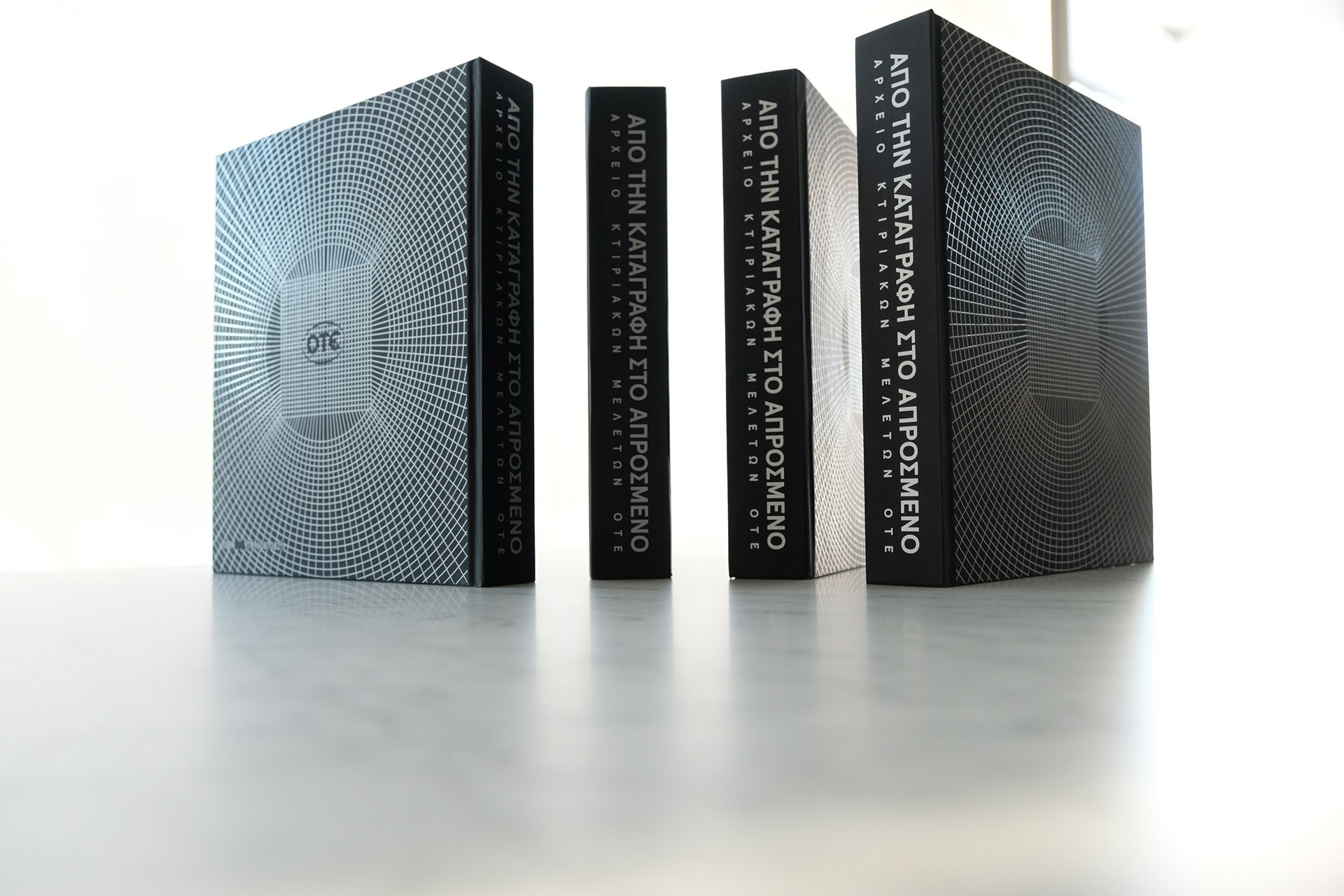
Το αρχείο του ΟΤΕ, μη προσβάσιμο στο κοινό, συστήνεται στη μεγαλύτερή του δυνατή λεπτομέρεια μέσα από αυτό τον κατάλογο. “Η αξιολόγηση και η ταξινόμηση των μελετών, ο συντονισμός των αρχείων, η σύμπτυξη της πληροφορίας, αποτελούν τη ραχοκοκαλιά αυτού του βιβλίου”. Ανάμεσα σε σημαντικές αρχιτεκτονικές αποτυπώσεις συναντούμε ανέκδοτο φωτογραφικό υλικό, που έρχεται σε άμεση αντίστιξη με το σήμερα, ιδίως την εποχή της πανδημίας. Εικόνες αναμονής στον γκισέ του τοπικού καταστήματος ή τους χώρους εργασίας των σχεδιαστριών, η μία δίπλα στην άλλη. “Ο ΟΤΕ είχε μία ολόκληρη γραμμή παραγωγής, έναν στρατό σχεδιαστών θα λέγαμε, που δείχνει την επιμονή και τη σημασία στην παραμικρή λεπτομέρεια”. Στις σελίδες του καταλόγου θα συναντήσουμε μικρές εκπλήξεις, σχεδόν ηθογραφικού χαρακτήρα, όπως για παράδειγμα ένα σχέδιο που παρουσιάζει μία ξυλουργική εφαρμογή τοίχου, με αποθηκευτικό χώρο για το διευθυντικό γραφείο. Πίσω από τα φύλλα του αποθηκευτικού χώρου κρύβεται ένας νιπτήρας με καθρέφτη και μία μικρή κρεμάστρα για την αποθήκευση του κουστουμιού -οι υποδομές τού χώρου επιβάλλουν στον εργαζόμενο τα απαραίτητα βήματα της σωστής εκπροσώπησης του ομίλου.

Είναι πολύ ενδιαφέρον πως στο αρχείο αυτό κανείς μπορεί να αναγνώσει μία παράλληλη νοοτροπία γύρω από τον σχεδιασμό. Όλα τα σχέδια, ιδίως μέσα από τη χειρωνακτική εργασία της εποχής, επαναφέρουν μία ανθρώπινη διάσταση, σε αντίθεση με τη σημερινή αρτιότητα και το στοιχείο του αψεγάδιαστου. “Για παράδειγμα, στις μελέτες ένταξης σε ιστορικό και παραδοσιακό περιβάλλον, θα δούμε την ανθρώπινη παρουσία σε νησιωτικά κτίρια με τα ανάλογα ενδύματα (όπως μαρινιέρες στη Μύκονο και μουσουλμανικές αμφιέσεις στη Θράκη). Επίσης, βλέπουμε μία προσαρμογή τής όψης των κτιρίων στην τοπική αρχιτεκτονική γλώσσα. Έτσι, στα κτίσματα της Ρόδου θα δούμε στιλιστικά δάνεια από την ιπποτική ή την ιταλική περίοδο του νησιού”.
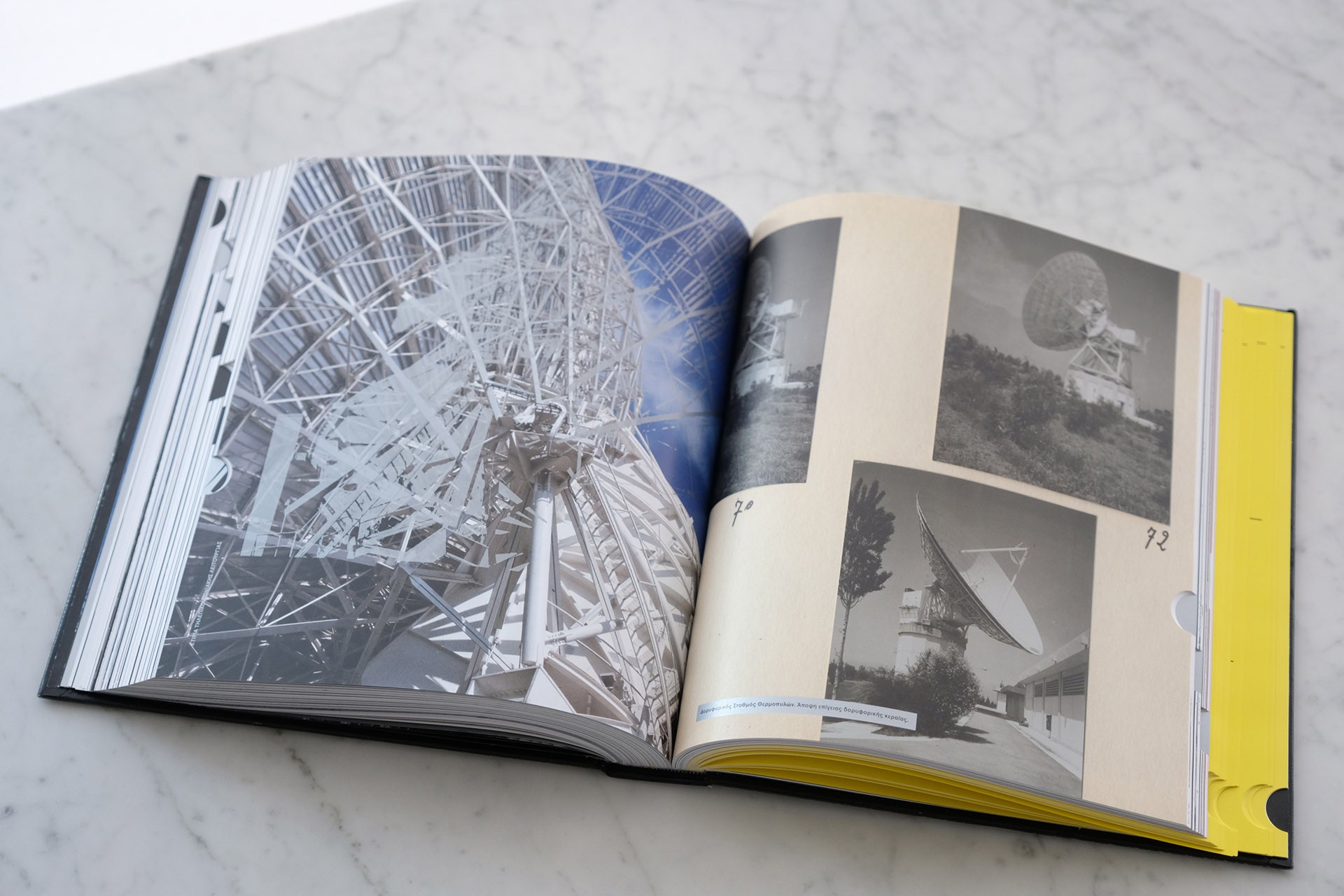
Ο τόμος σχεδιάζεται, πέραν του layout, ως μία απτική εμπειρία. Το εξώφυλλο, με μία ομόκεντρη αφηγηματική γεωμετρία, είναι ανάγλυφο και είναι η κατασκευαστική λεπτομέρεια μιας δεξαμενής καλωδίων. “Ίσως ήταν η μοναδική στιγμή ομοφωνίας από όλους τους εμπλεκόμενους συντελεστές. Στην αφαίρεσή του, το σχέδιο αυτό επικοινωνεί περισσότερο από ποτέ την έννοια του δικτύου και της τεχνολογίας.” Το σώμα του τόμου επαναφέρει βιωματικές κινήσεις στον αναγνώστη. Στο σόκορο του βιβλίου υπάρχουν εγκοπές στο μέγεθος που θυμίζουν τα παλιά ευρετήρια, ενώ το Index των μελετών αναπτύσσεται σε κίτρινες σελίδες, με αναφορά στον παλιό Χρυσό Οδηγό.
Από την Καταγραφή στο Απρόσμενο. Αρχείο Κτιριακών Μελετών ΟΤΕ
Συγγραφέας/είς: Γιώργος Αθανασόπουλος, Γιάννης Αθανασόπουλος, Ελένη Κανετάκη, Νίκος Συριόπουλος, Θεοδόσιος Π. Τάσιος, Μιχάλης Τσαμάζ, Γιάννης Χατζηνικολής
Επιμέλεια: Νίκος Συριόπουλος
Εκδότης: Οργανισμός Τηλεπικοινωνιών της Ελλάδος Α.Ε.
ISBN: 9789608708211
Ημερομηνία έκδοσης: 2021
Φωτογραφίες: Τάσος Βρεττός
FLESH

“Το βιβλίο αυτό το είχα πρωτοδιαβάσει όταν ήμουν φοιτήτρια. Είναι έκδοση του ’94, η πρώτη έκδοση αναφορικά με το έργο των Diller & Scofidio”. Πριν από τα σημαντικά κτίρια του γραφείου που γνωρίζουμε σήμερα, “βλέπουμε μία επίμονη αναζήτηση της σχέσης σώματος-χώρου-τεχνολογίας”. Το βιβλίο διατρέχει ένα συνεχές κείμενο, στο οποίο παρεμβάλλονται σχόλια, υποσημειώσεις, εικόνες, συνθήματα. “Πρώτη φορά έβλεπα ένα τέτοιο layout. Μου δημιουργεί τρομερή αδρεναλίνη κάθε φορά που το διαβάζω. Ως αναγνώστης διαλέγεις διαφορετικό μονοπάτι στο κείμενο, προσπαθείς να βρεις τον ρυθμό σου, αλλάζεις και αλλάζεις ταχύτητα. Κάθε ανάγνωση είναι διαφορετική εμπειρία”. Το περιεχόμενο, στοιχειοθετημένο ως ένα ιδιότυπο index, παρουσιάζει ένα πλήθος από εικαστικά, αρχιτεκτονικά και σχεδιαστικά projects, με μία performative διάσταση. Χαρακτηριστική είναι η αναφορά στην instructional art, που χρησιμοποιείται εδώ μέσα από μία σειρά οδηγιών, “πώς να διπλώσετε ένα πουκάμισο” —ένα σχόλιο στη σχέση κοινωνίας, λειτουργικότητας και του καθημερινού. Όλες αυτές οι χειρονομίες σηματοδοτούν έναν τρόπο σκέψης για το design και την αρχιτεκτονική, στον άξονα που χάραξαν.
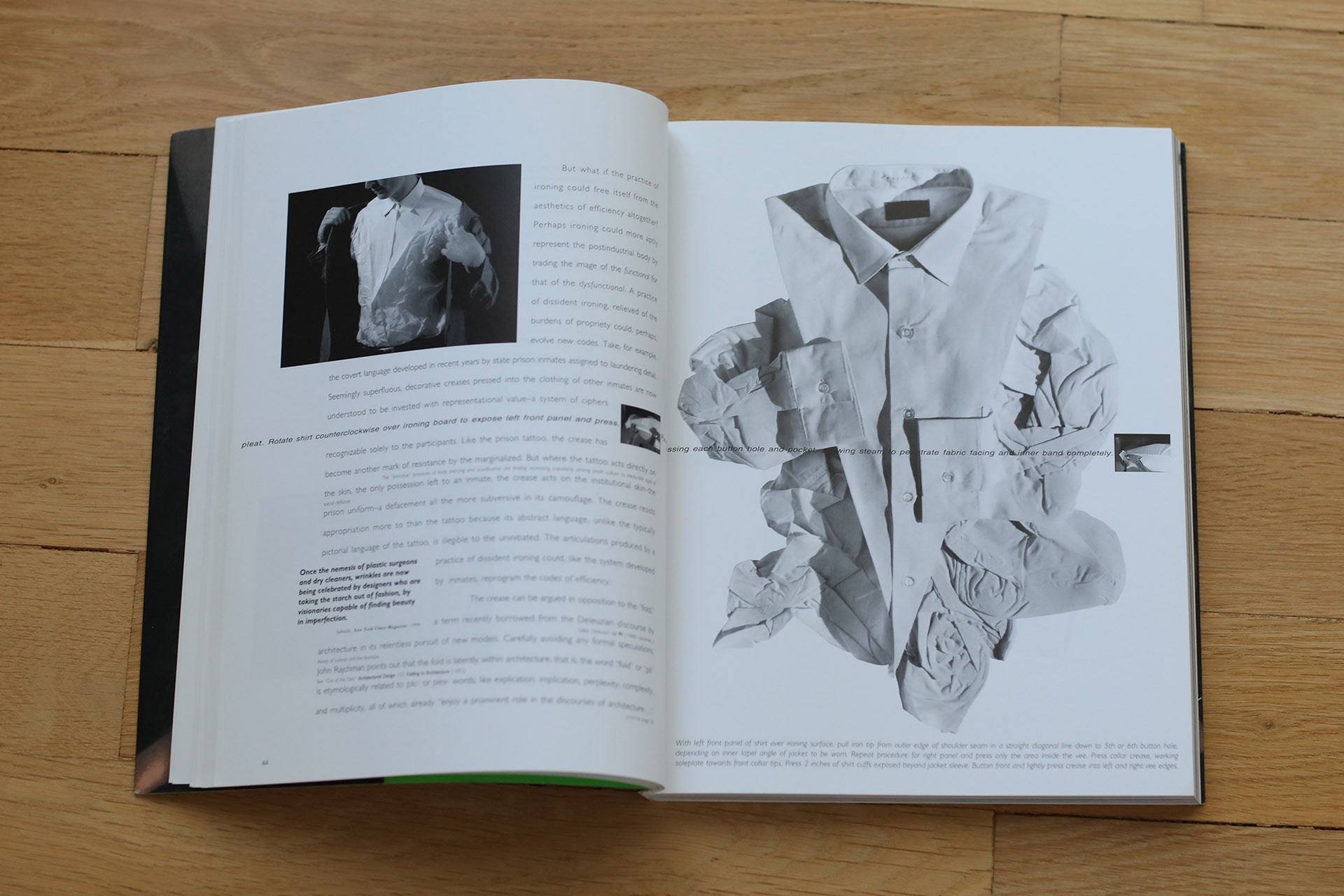
Οι D&S, μέσα από μια σειρά διατυπώσεων για τη λειτουργία του τουρισμού και των παραθεριστικών προορισμών, αποκαλύπτουν έναν κυκλικό μηχανισμό, από το σημείο sick of home στο σημείο homesick. “Ειδικά με τη συνθήκη του εγκλεισμού στην πανδημία, η σχέση αυτή με απασχόλησε. Στην Ελλάδα, η ζωή μας εξελίσσεται εκτός σπιτιού, στον δημόσιο ανοιχτό χώρο. Ένας λόγος που ενδεχομένως υπολειπόμαστε σε σχέση με άλλες χώρες στο κομμάτι της κουλτούρας του design, είναι αυτός. Στην πανδημία ξαναστραφήκαμε στο εσωτερικό, αποκλειστικά και ολοκληρωτικά, αναδιατυπώσεις με τέτοιον τρόπο ώστε να είμαστε παραγωγικοί μέσα από το σπίτι για το σπίτι, με τέτοιον τρόπο που οι δύο έννοιες (sick of home - homesick) να βρίσκονται σχεδόν σε καταστολή”.
Flesh: Architectural Probes
Συγγραφέας/είς: Elizabeth Diller, Ricardo Scofidio
Εκδότης: Princeton Architectural Press
ISBN: 9781878271372
Ημερομηνία έκδοσης: 1998 (1st edition)
ΕΡΩΤΙΣΜΟΣ

“Είναι ένα βιβλίο, που κάθε φορά που το διαβάζω είναι καινούριο”. Οι έννοιες που εισάγει ο Γάλλος φιλόσοφος και λογοτέχνης, ενώ δεν αφορούν το design, “με ελκύει να τις απομονώνω και να τις ξαναβλέπω σε άλλο πλαίσιο. Το design συχνά φλερτάρει με τα όρια της τέχνης ή της αρχιτεκτονικής. Θα μπορούσαμε να κοιτάξουμε αυτές τις στιγμές ως μια ανάλογη υπέρβαση ορίου, ως μια λεπτή γραμμή που, όταν ξεπερνιέται και το ένα πεδίο παρεισφρέει στο άλλο, συμβαίνει κάτι μαγικό”. Οι υπερβάσεις αναλύονται στον Ερωτισμό μέσα από τους διαχωρισμούς σε “ναρκισσιστική διαταραχή και απόλαυση μονάδας”, σε υποτακτικότητα και “σχέση αγαπόμενου και αγαπόντα” ή στη σχέση “έκστασης και ιερού”. Η σύνδεση αυτών των σκέψεων με το design αποκαλύπτονται στη διατύπωση του επίπλου. “Εκεί ο designer αποτυπώνει την πιο προσωπική χειρονομία για την υποδοχή (accommodation) ενός αγαπημένου προσώπου. Οι designers, στον ρόλο του καλού οικοδεσπότη, εμφαίνουν τη σχέση φροντίδας και design -ίσως όχι δεδομένο πια. Προσπαθώ να κοιτάζω το design μέσα από τέτοια πρίσματα, και ανακαλύπτω συχνά τέτοιες ευχάριστες συμπτώσεις”.
Ο Ερωτισμός
Συγγραφέας/είς: Bataille Georges
Εκδότης: Ίνδικτος
ISBN: 9789605184858
Ημερομηνία έκδοσης: 2006 (1η έκδοση στα ελληνικά από τον εκδοτικό οίκο Ίνδικτο)
ATLAS OF FURNITURE
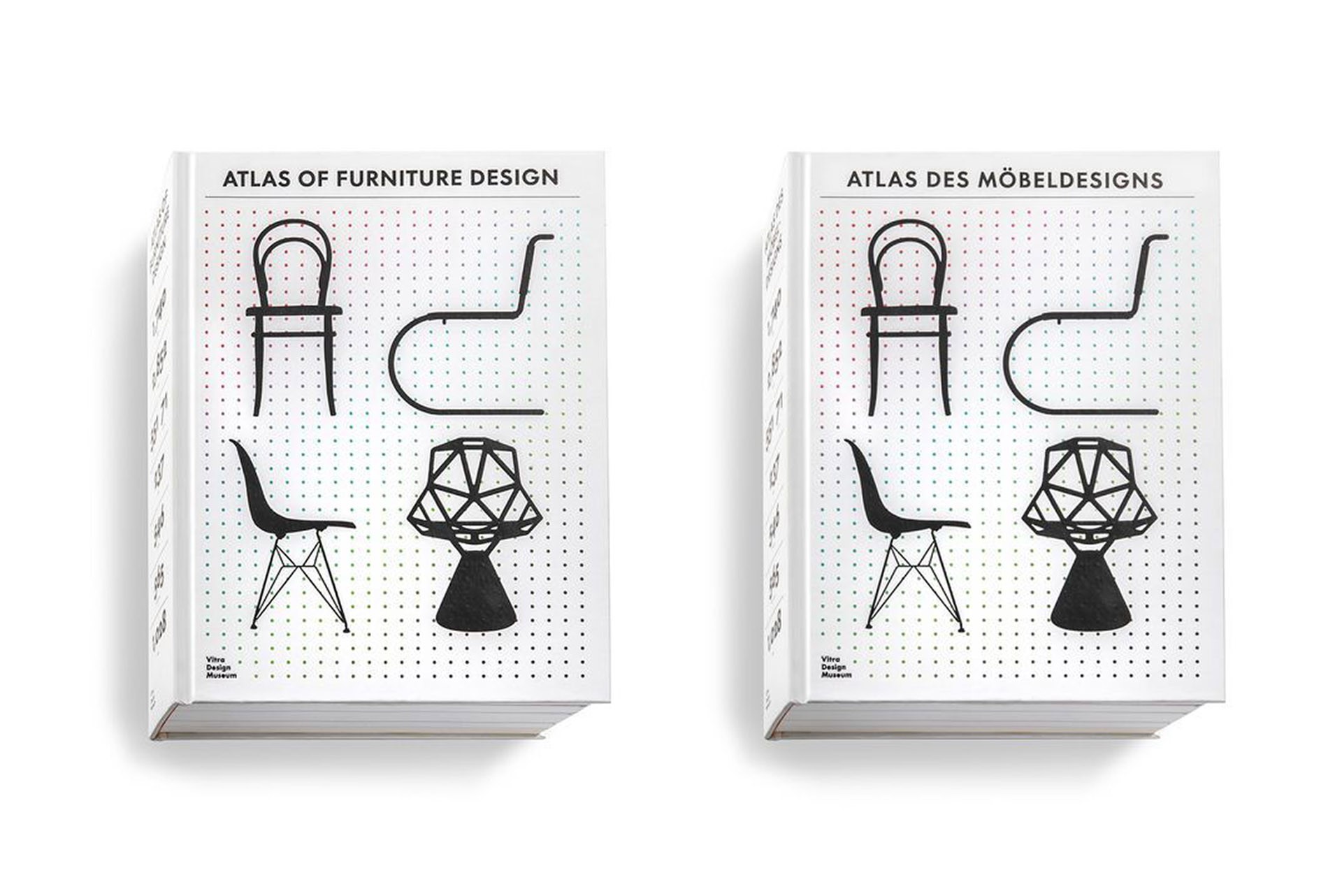
“Με ιντριγκάρει τρομερά η ιδέα του άτλαντα”. Πρόκειται για μια εντυπωσιακή, ογκώδη έκδοση, η οποία "χαρτογραφεί" όλα τα έπιπλα, χρονολογικά, με βάση το είδος, τον τρόπο κατασκευής, το υλικό, τη χώρα, και τα εξηγεί με σαφήνεια και σχεδόν γενεαλογική συνέπεια. “Είναι η ταξινόμηση και η επεξεργασία ενός τεράστιου πραγματικά όγκου πληροφοριών, με τρόπο τέτοιο ώστε να γίνει η πληροφορία προσβάσιμη στον οποιονδήποτε. Ειδικό και μη”. Στην αρχή, ένα πολύχρωμο matrix σημείων, ένα πρωταρχικό υπόμνημα του τόμου, ώστε να περιηγηθούμε στα έπιπλα τα οποία θα αναλυθούν παρακάτω. “Μπορείς να χαθείς μέσα σε αυτό το βιβλίο… Κι εκεί έρχεται το ίδιο το βιβλίο να σου υπενθυμίσει πώς να το διαβάσεις. Μια υπόδειξη καλής ανάγνωσης”. Το βιβλίο εμπλουτίζεται με πολλαπλά διαγράμματα και περαιτέρω κατηγοριοποιήσεις, κάνοντάς το αρκετά διασκεδαστικό. Έχει πολύ ενδιαφέρον η γενεαλογία του επίπλου, όπως παρουσιάζεται “πως δημιουργούνται οικογένειες, όπως οι δικές μας. Πως υπάρχουν συγγένειες, επιρροές, ερεθίσματα που μεταφέρονται από τον ένα τόπο στον άλλο, και πώς εξελίσσεται η βιομηχανία. Είναι κάτι περισσότερο από την ιστορία του επίπλου. Τα αντικείμενα μιλάνε για τη φιλοσοφία του design και την εποχή τους. Μιλάνε, τέλος, για τις σχέσεις μεταξύ υλικών και σχεδίων”, πώς αυτά προκύπτουν ως καινοτομίες και ανατρέπονται μέσα στην πορεία της ιστορίας, βάσει των νέων κάθε φορά δεδομένων.
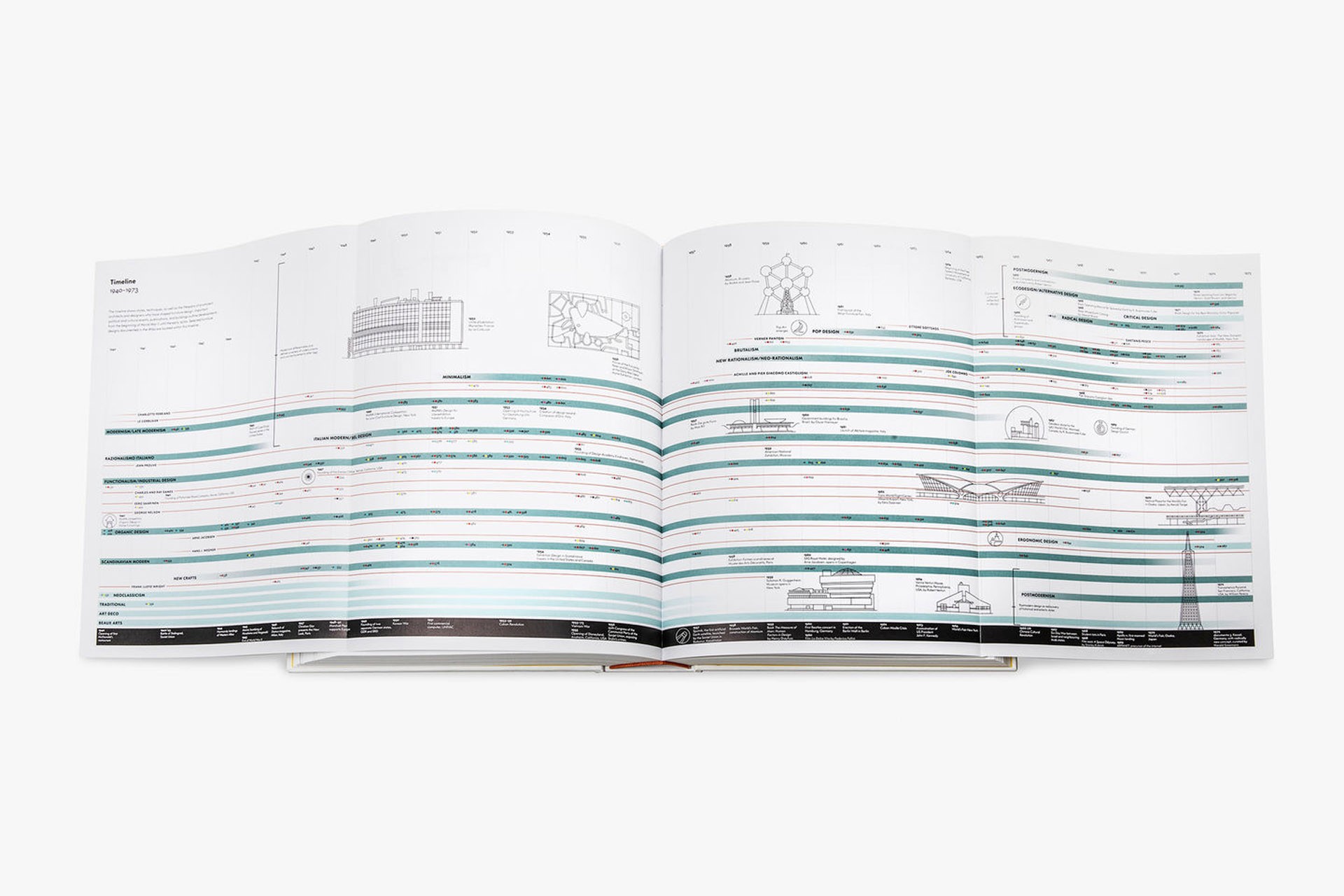
Atlas Of Furniture Design
Συγγραφέας/είς: Kries Mateo, Eisenbrand Jochen
Εκδότης: Vitra Design Museum
ISBN: 9783931936990
Ημερομηνία έκδοσης: 2018
NIGHT FEVER
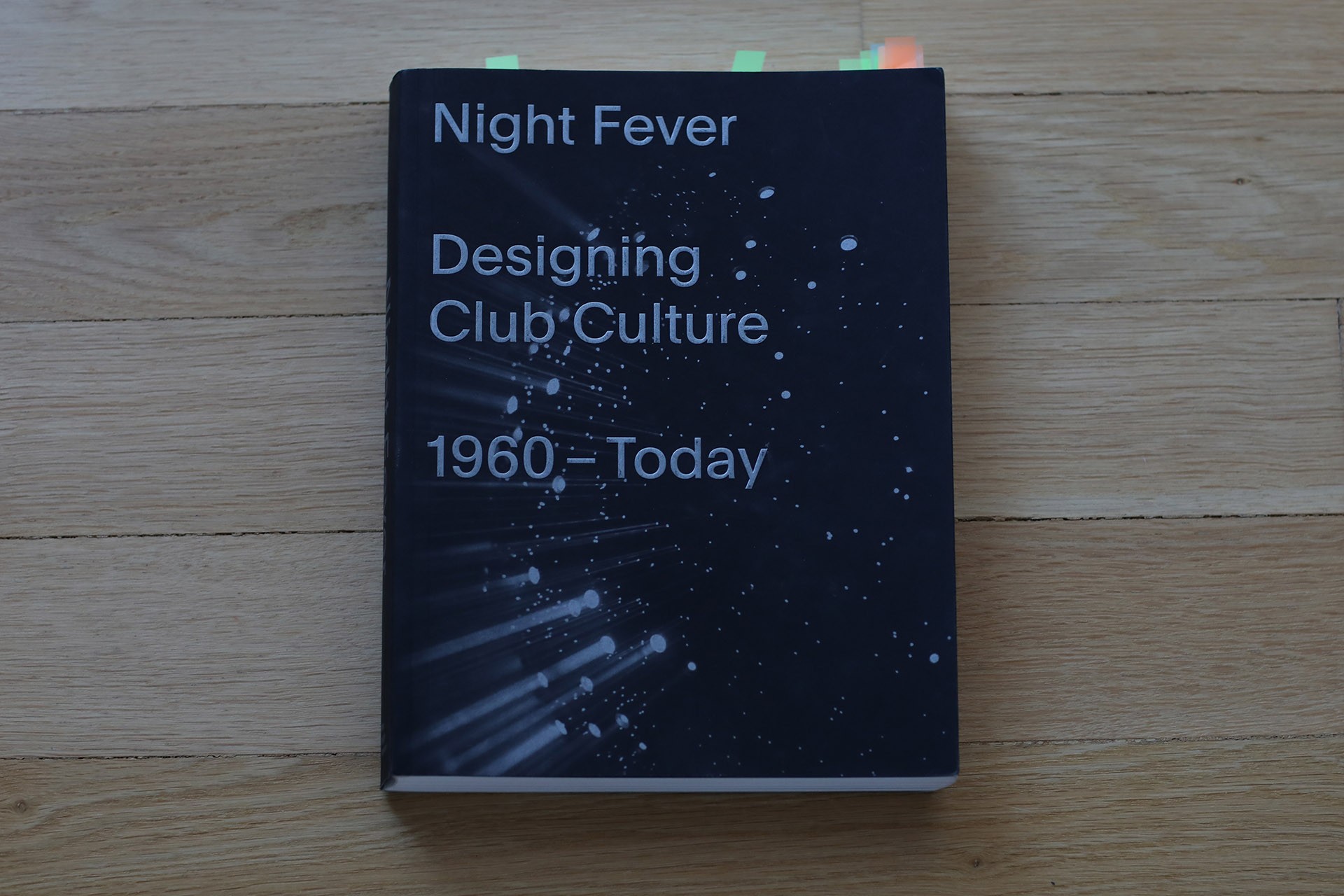
Ακόμη ένα προφητικό έργο εν μέσω πανδημίας. “Το βιβλίο αυτό είναι ο κατάλογος μιας μεγάλης έκθεσης, που πραγματοποιήθηκε στο Vitra Design Museum το 2019. Πρόκειται για μία έρευνα γύρω από την αρχιτεκτονική των clubs, των χώρων διασκέδασης ως ένα πεδίο συνάντησης design, new media και των εναλλακτικών τρόπων ζωής”. Ο κατάλογος αποτυπώνει μέσα από πρωτότυπο φωτογραφικό υλικό τον κόσμο αυτών των χώρων, ενώ ταυτόχρονα καταγράφει και την παρουσία ιστορικών αντικειμένων που υπήρχαν σε κλαμπ, όπως synthesizer, πικάπ, φωτορυθμικά και ηχεία. Φυλλομετρώντας το βιβλίο, ο αναγνώστης θα βρεθεί σε ιστορικά club όπως το Palladium. Πίσω από την κεντρική μπάρα θα δούμε ένα τεράστιο μουράλ του Μπασκιά, ο Κιθ Χάρινγκ θα ζωγραφίζει την Grace Jones και σε ένα από τα τραπέζια ο Άντι Γουόρχολ θα διασκεδάζει με την παρέα, φορώντας τα χαρακτηριστικά του γυαλιά ηλίου. “Έχει ενδιαφέρον να συζητάμε σήμερα για τη συνθήκη, τους τρόπους και την παράδοση της διασκέδασης πριν την πανδημία και να τις συγκρίνουμε με αυτά που θα ακολουθήσουν. Η διασκέδαση, η επαφή, η εγγύτητα, ο χώρος, μεταβάλλονται. Είναι υπό διαπραγμάτευση και θα μπορούσαμε να πούμε πως η απόσταση αυτή μεταφέρει την προηγούμενη κατάσταση σε μια φούσκα ιστορικότητας. Ο κατάλογος φέρει το design σε πρώτο πλάνο, πέραν του αντικειμένου, μιλάει για το design ως αυτό που περικλείει εντός του την εκάστοτε μορφή διασκέδασης, “μια ατμόσφαιρα”. “Βλέπουμε πως στην τυπολογία τού club εμφανίζεται η λογική τού dance floor στα χρόνια της disco”, ενώ αργότερα, με την ανάδυση της rave μουσικής, πως ο χώρος που συμμετέχει έχει βιομηχανικά χαρακτηριστικά. Είναι σαν να γνωρίζεις τι μουσική παίζει εντός τής κάθε φωτογραφίας. Η συλλογή αποπνέει ένα αίσθημα νοσταλγίας σε σχέση με το σήμερα. “Οι χώροι επιδραστικοί, το design δηλωτικό. Τι να ακολουθεί άραγε;”

Night Fever. Designing Club Culture 1960-Today
Συγγραφέας/είς: Jörg Heiser, Tim Lawrence, Ivan Lopez Munuera, Catharine Rossi, Sonnet Stanfill, Alice Twemlow, Ben Kelly, Peter Saville, Ian Schrager
Επιμέλεια: Mateo Kries, Jochen Eisenbrand, Katarina Serulus
Εκδότης: Vitra Design Museum
ISBN: 9783945852248
Ημερομηνία έκδοσης: 2018





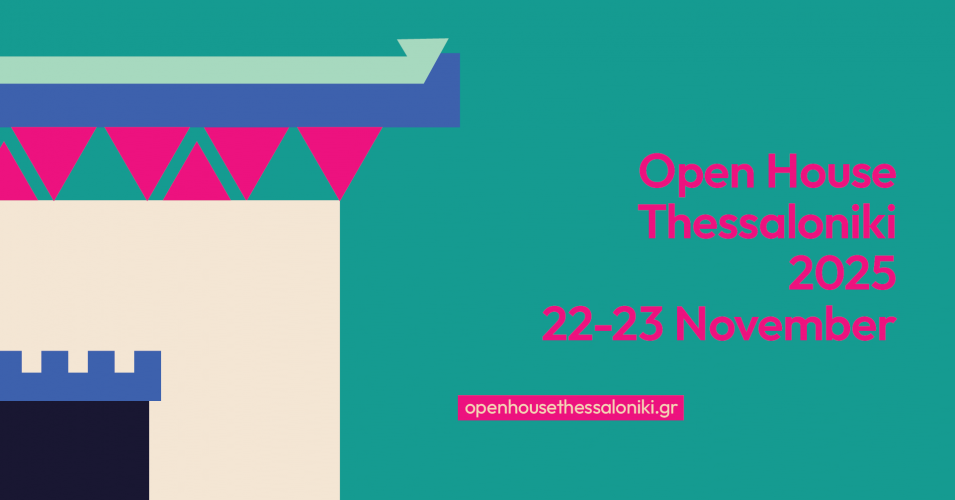
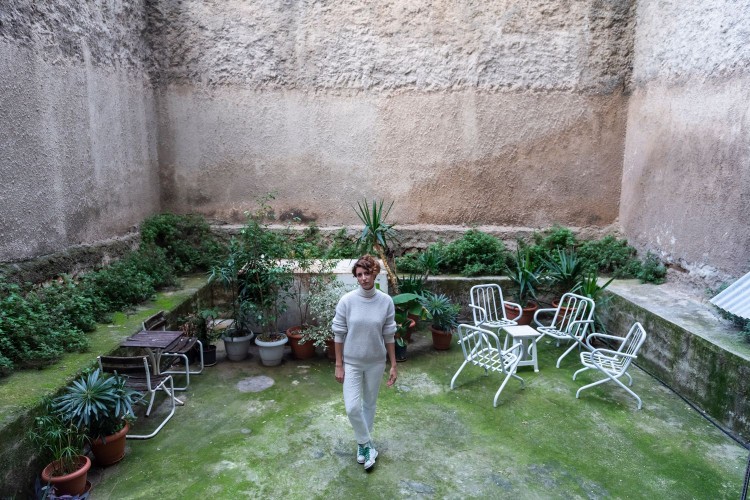
.jpg)
 (1).jpg)